
Virtual remote appointments are available. Contact us for a video telehealth evaluation.

All appointments conducted by our Board Certified doctor and not assistants or non-physician providers.
What is Plantar Fasciitis
Plantar fasciitis is one of the most common causes of heel pain and affects approximately 10% of the population at some point in their lives. Plantar fasciitis is characterized by inflammation of the plantar fascia—a thick band of tissue that runs across the bottom of the foot connecting the heel bone to the toes—plantar fasciitis can cause sharp pain, typically experienced in the morning or after long periods of inactivity. While conservative treatments such as rest, physical therapy, and orthotics can provide relief for many, some patients with chronic or severe plantar fasciitis may find themselves in need of more advanced interventions. Embolization has emerged as a promising, minimally invasive option for treating refractory cases of plantar fasciitis, offering patients an alternative to surgery with fewer complications and quicker recovery times.
Treatment Options for Plantar Fasciitis
Plantar fasciitis is a condition that results from repeated stress and strain on the plantar fascia, leading to inflammation and microtears. This inflammation can cause significant pain and discomfort, particularly in the heel area. Common risk factors include prolonged standing, obesity, improper footwear, and high-impact sports like running or basketball.
Traditional treatments for plantar fasciitis focus on alleviating inflammation and reducing strain on the plantar fascia. These treatments include:
- Rest and Ice: Reducing physical activity and applying ice can help decrease inflammation and pain.
- Physical Therapy: Stretching exercises and strengthening the calf muscles can reduce stress on the plantar fascia.
- Orthotic Devices: Custom-made insoles or heel cups are designed to support the foot and reduce the strain on the plantar fascia.
- Nonsteroidal Anti-inflammatory Drugs (NSAIDs): Medications such as ibuprofen or naproxen are often prescribed to help reduce pain and inflammation.
- Steroid Injections: Corticosteroid injections can be administered to relieve severe inflammation, though their effects are often temporary, and repeated use can cause tissue damage.
Despite the effectiveness of these treatments for many, approximately 10% of individuals with plantar fasciitis will not experience relief through conservative measures and may require more aggressive treatments such as surgery or newer, minimally invasive procedures like embolization.
Embolization in Treating Plantar Fasciitis
Embolization is a minimally invasive procedure that has been around for over 30 years and traditionally used to treat conditions such as cancers, large prostates, bleeding, pain, vascular disorders and tumors among others. Recently, this technique has been adapted to treat musculoskeletal conditions like plantar fasciitis by targeting the abnormal blood vessels that supply the inflamed tissue, called Plantar Fasciitis Embolization (PFE).
In cases of chronic plantar fasciitis, researchers have observed an increase in abnormal neovascularization (the growth of new blood vessels) around the inflamed plantar fascia. These new blood vessels are believed to contribute to the chronic inflammation and persistent pain associated with the condition. Embolization works by blocking these abnormal blood vessels, thereby reducing blood flow to the inflamed tissue, which in turn decreases inflammation and promotes healing.
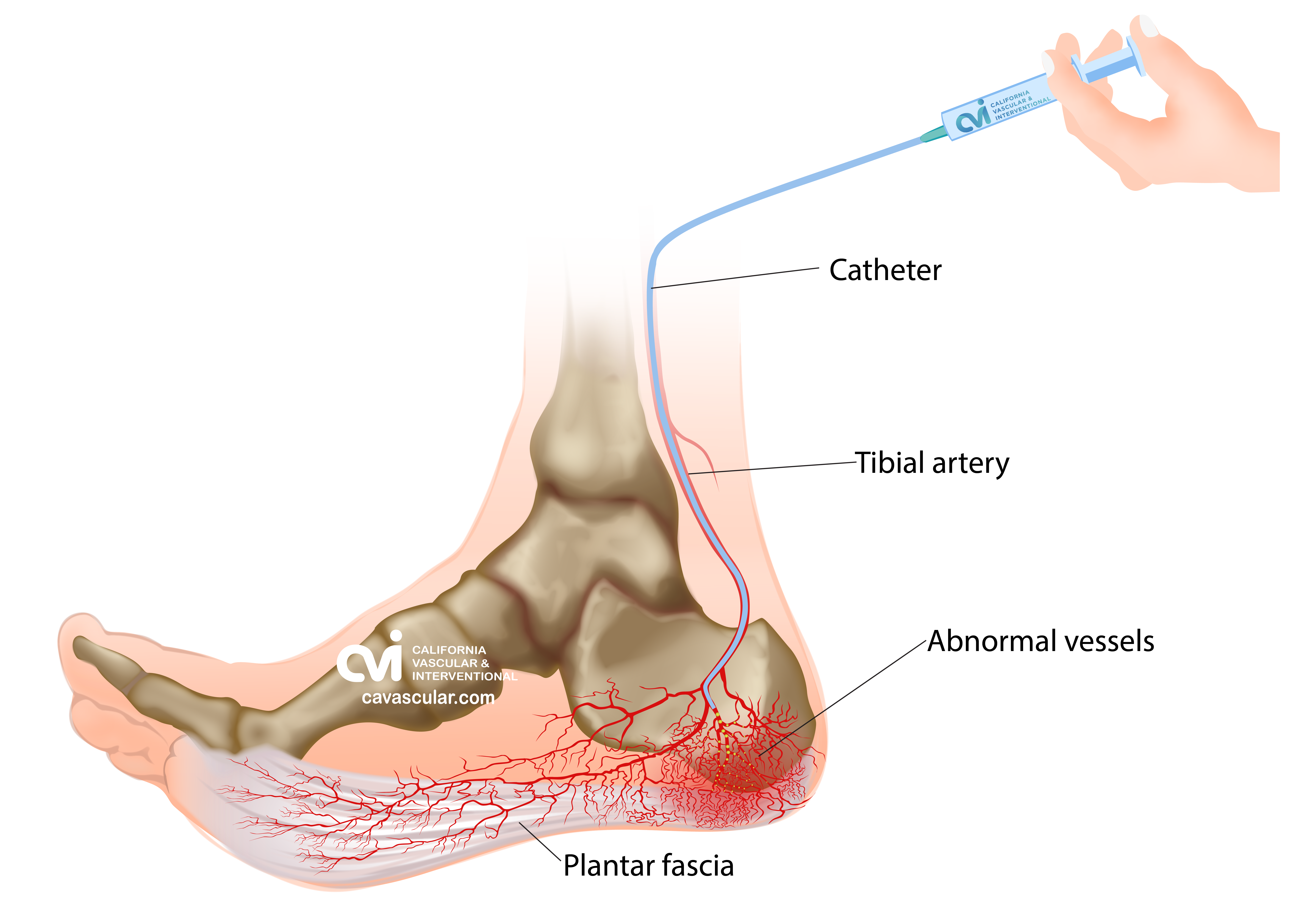
How Embolization Treatment Works for Plantar Fasciitis
Plantar Fasciitis Embolization (PFE) is performed by our double board-certified interventional radiologist under local anesthesia.
After a small numbing injection, a tiny “IV like” catheter is inserted into the blood vessel at the ankle, using real-time ultrasound and sometimes x-ray imaging. Once the catheter is in position, tiny embolic antibiotic agents are introduced into the blood vessels to block the abnormal vessels. The embolic agents cut off the blood supply to the abnormal vessels but leave normal vessels intact, reducing inflammation and pain in the affected area.
The entire procedure usually takes about 30-60 minutes and is performed on an outpatient basis, meaning patients can go home the same day. Most patients report minimal discomfort during the procedure, and many can resume normal activities within a few days. There is no downtime for this procedure.
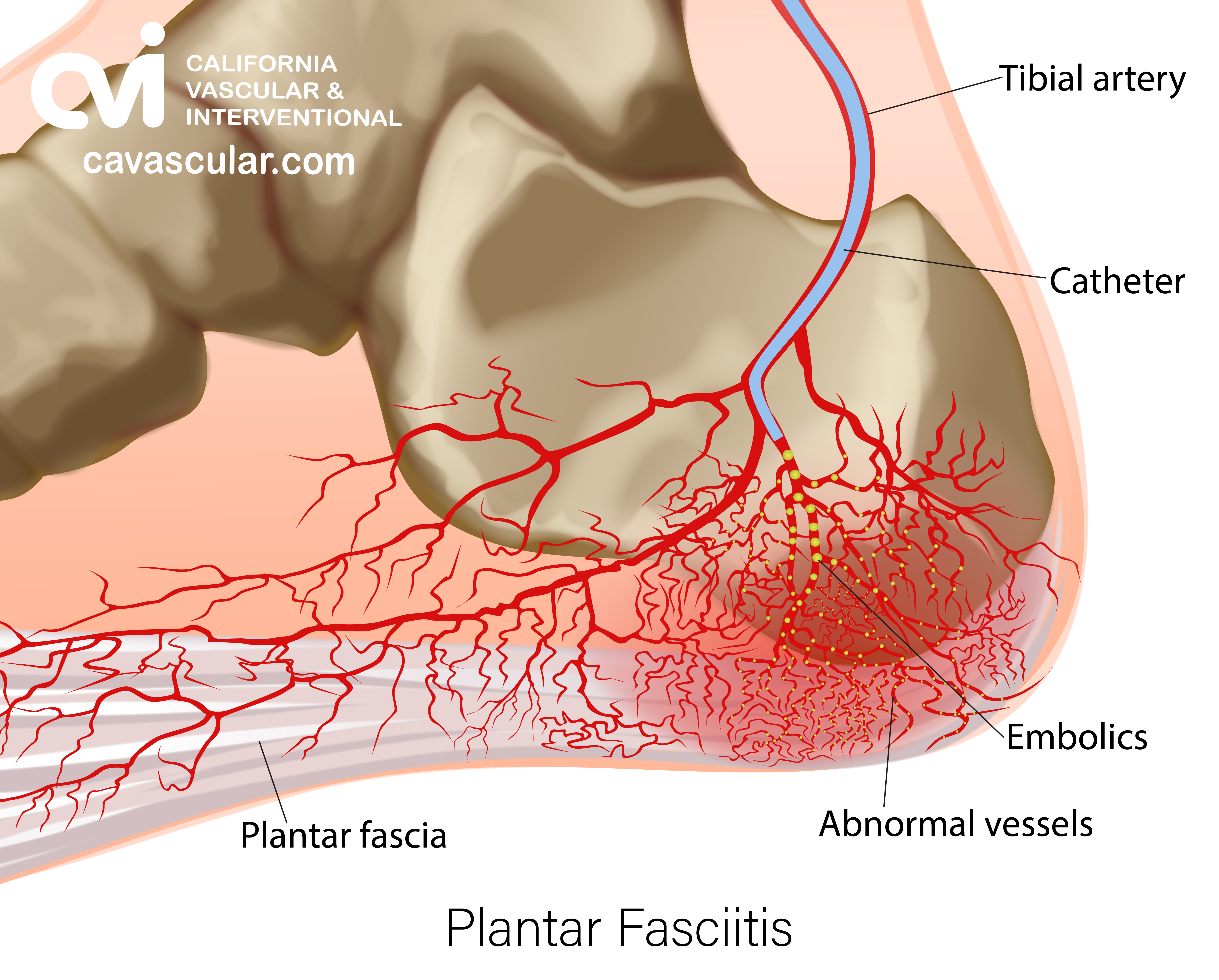
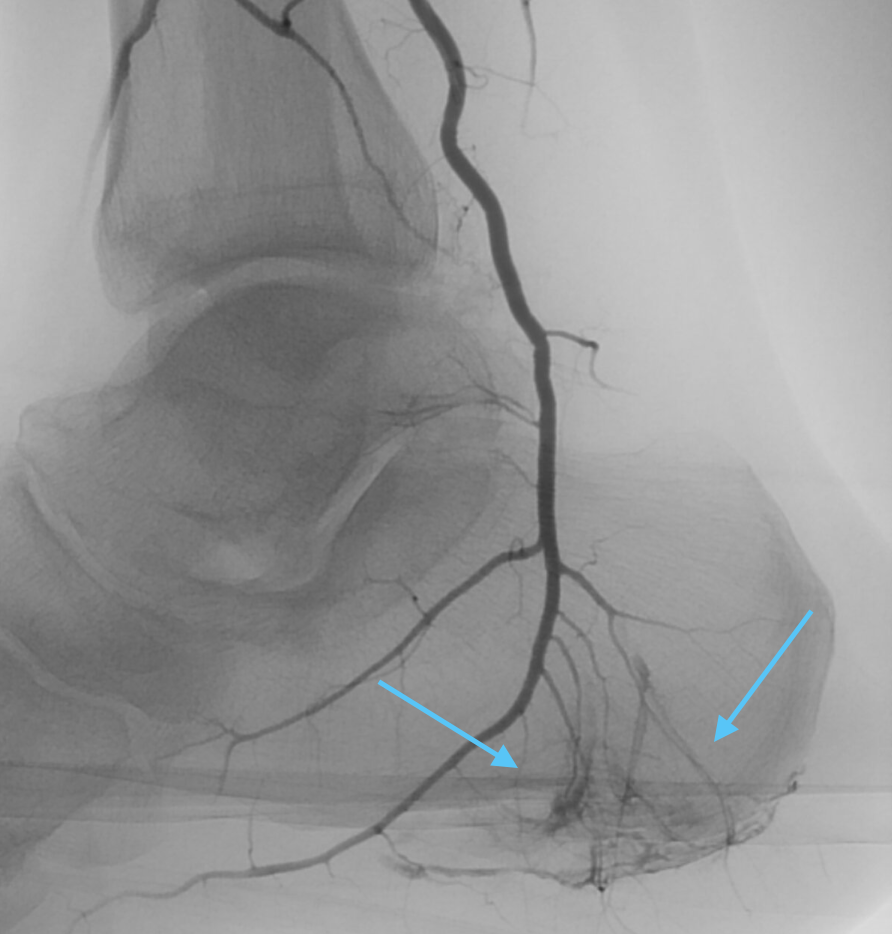
Benefits of Plantar Fasciitis Embolization (PFE) Treatment
- Minimally Invasive: Unlike traditional surgery, which requires incisions and longer recovery times, embolization is performed through a small puncture in the skin. This results in less trauma to the surrounding tissues, minimal scarring, and reduced risk of infection.
- Effective Pain Relief: Several studies have shown that embolization can significantly reduce pain in patients with chronic plantar fasciitis. For example, a study by Okuno et al. (2013) reported that 80% of patients experienced substantial pain relief after embolization, with many reporting long-lasting benefits even after one year of follow-up.1 Dr Allaei has seen first-hand how Dr Okuno treats patients in Japan with plantar fasciitis and has employed a similar method. Another study published in The Journal of Vascular and Interventional Radiology found that embolization resulted in a 90% reduction in pain for patients with refractory plantar fasciitis. 2
- Faster Recovery: Compared to surgical options such as plantar fasciotomy, embolization offers a quicker recovery time. Most patients are able to return to their normal activities within a few days, whereas recovery from surgery can take several weeks to months.
- Low Risk of Complications: Embolization has been shown to have fewer complications than traditional surgery. Because there is no need for incisions or cutting of the plantar fascia, the risk of nerve damage, infection, or weakening of the foot’s support structures is significantly reduced. Patients undergoing embolization also avoid the long-term risks associated with steroid injections, such as tendon weakening or rupture. Additionally, Dr Allaei uses a safe antibiotic crystalline form of an embolic rather than a permanent particle which further reduces the risk of the procedure.
- Non-Surgical Alternative: For individuals who have not found relief through conservative treatments but wish to avoid surgery, embolization provides an attractive alternative. It offers effective pain relief without the need for invasive surgical procedures.
Success Rates of Embolization Treatment for Plantar Fasciitis
Clinical studies have reported high success rates for embolization as a treatment for chronic plantar fasciitis. In the study by Okuno et al., 80% of patients experienced significant improvements in pain and quality of life following the procedure. Similarly, a retrospective study published in 2017 found that embolization had a success rate of over 85% in reducing pain and improving function in patients with chronic heel pain. 3
These success rates are comparable to, if not better than, those reported for traditional surgical interventions, such as plantar fasciotomy, which has a success rate of around 70% to 90%, but carries a higher risk of complications and longer recovery times.
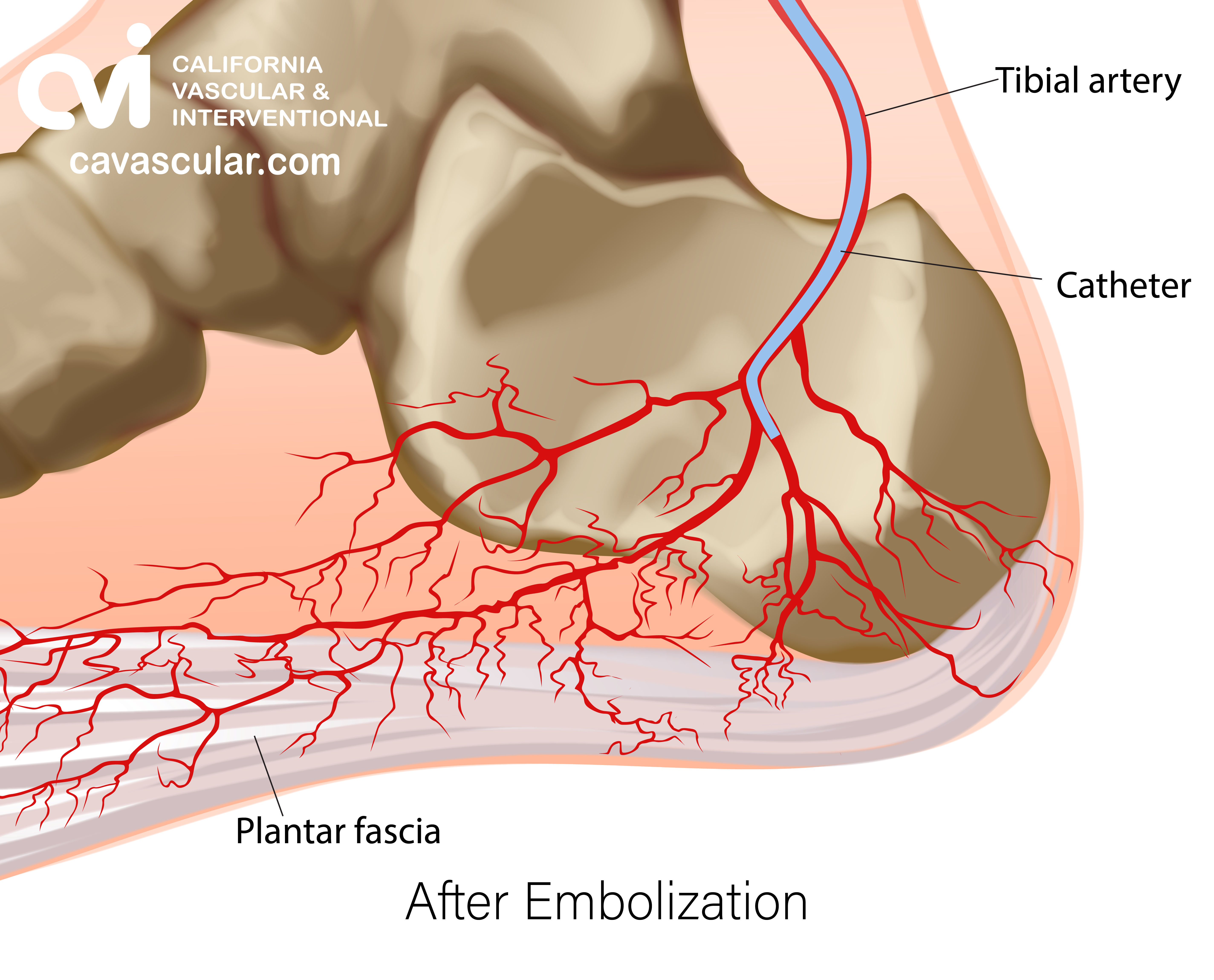
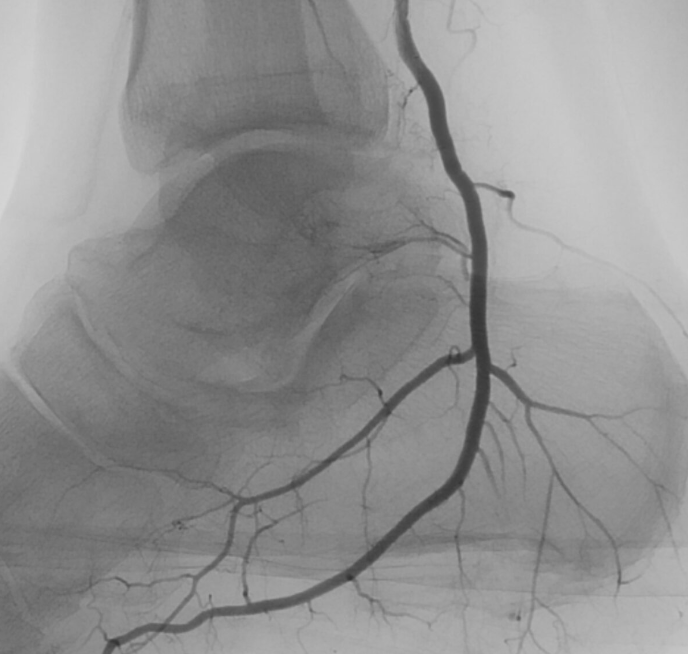
Potential Risks of Embolization Treatment
While embolization is generally considered safe and well-tolerated, as with any medical procedure, there are some potential risks. These may include:
- Infection: Although rare, there is a small risk of infection at the catheter insertion site.
- Non-Target Embolization: In some cases, the embolic agents may block blood vessels that were not intended to be targeted, potentially causing tissue damage. Dr Allaei uses a dissolvable embolic which significantly reduces any risk of non-target embolization; this is a similar to Dr Okuno’s approach who has done a lot of the early research on this treatment.
- Temporary Pain: Some patients may experience a temporary increase in pain during or just after the procedure, which subsides. We do not need to prescribe any pain medication.
Overall, the risks associated with embolization are minimal, especially when compared to the potential risks of surgery or long-term steroid use.
Why Embolization for Plantar Fasciitis?
Embolization is an innovative and minimally invasive treatment option for patients with chronic plantar fasciitis who have not found relief through conservative measures. By targeting the abnormal blood vessels that contribute to inflammation, embolization can provide significant and long-lasting pain relief with minimal risks and quicker recovery times compared to traditional surgery. As more research continues to support its effectiveness, embolization may become a more widely accepted alternative to surgery for treating plantar fasciitis, offering hope to those suffering from this painful condition.
Why CVI?
Our center specializes in embolizations, and our staff is uniquely trained to care for these types of procedures, from the pre-op to the post-op period. Our specialist performs a high amount of embolization for not only the foot, knee, and shoulder but also in other more high risk and complex organs, such as the kidney, thyroid, liver, lung, uterus, prostate and others. Dr Allaei has employed a similar technique as Dr Okuno, who first discovered the benefits of embolization for musculoskeletal issues, and Dr Allaei brings this experience from Japan to our practice. Patients are often surprised how quick and simple the procedure was for them, but this comes at the experience of our specialist who performs a variety of complex embolizations safely. This diversity of experience has resulted in our specialist to treat complex cases safely and effectively.
Our specialist continually keeps up with the research to make sure that he brings the best and newest technology and technique to our center. We are also always collecting feedback from patients and modifying how we provide care so that patients have the best level of experience.
What do you need to do next? Request an appointment to meet with our embolization doctor who will review your imaging, labs and history to determine if you are candidate for the procedure, and the outcomes you can expect.
Appointments are available via an online video telehealth platform or in person at one of the offices in Los Angeles, Orange County or San Diego, depending on the doctor’s availability. Contact Us Today. Why should you choose us? Read here.
References
- Okuno, Y., Iwamoto, W., & Terashima, M. (2013). “Plantar Fascia Hemodynamics in Plantar Fasciitis with Ultrasound and Their Therapeutic Response to Embolization.” *Journal of Vascular and Interventional Radiology*, 24(11), 1684-1689.
- Omoto, T., et al. (2017). “Efficacy of Arterial Embolization for the Treatment of Refractory Plantar Fasciitis: A Retrospective Study." *Journal of Vascular and Interventional Radiology*, 28(9), 1242-1247.
- Yamada, K., et al. (2015). “Arterial Embolization as a Treatment Option for Recalcitrant Plantar Fasciitis." *Journal of the American Podiatric Medical Association*, 105(6), 536-542.
The above information explains what is involved and the possible risks. It is not meant to be a substitute for informed discussion between you and your doctor, but can act as a starting point for such a discussion.
